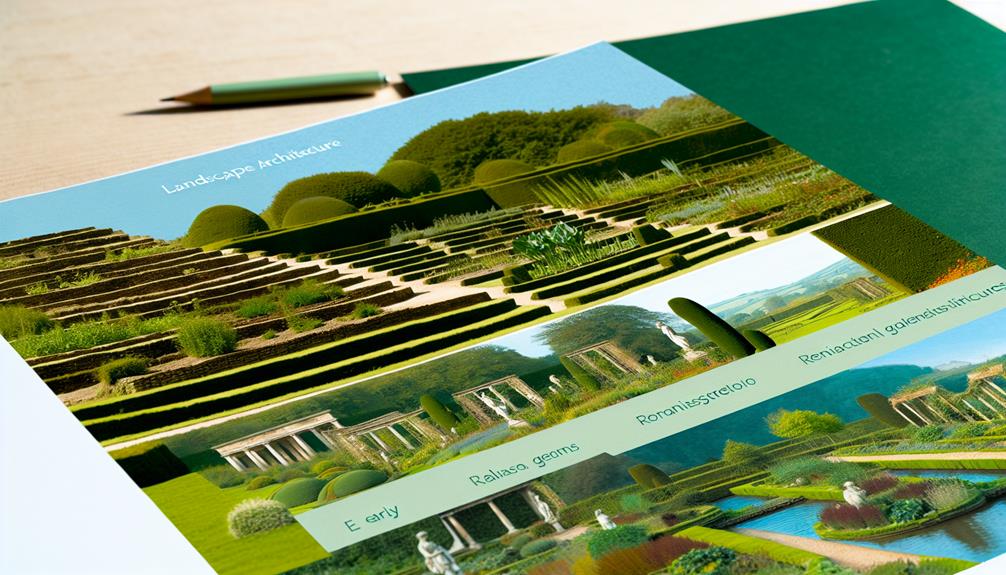So you’re curious about the world of landscape architecture, a profession that delicately shapes and enhances outdoor spaces. It’s a field that brings together the artistry of design, the precision of architecture, and the wisdom of environmental science.
But there’s so much more to this profession than meets the eye. From the rich history and evolution of landscape architecture to its role in urban planning and sustainability, there are endless facets to explore.
And if you’re wondering about the education and professional requirements, we’ve got you covered. So, let’s dive in and uncover the secrets of this captivating profession.
Definition of Landscape Architecture

Landscape Architecture combines art and science to design, plan, and manage land for various traditional places such as parks, residential developments, campuses, and gardens. As a landscape architect, you play a crucial role in shaping outdoor living spaces that are both aesthetically pleasing and functional. The definition of landscape architecture encompasses the integration of design, planning, and science to create environments that enhance the quality of life for individuals and communities.
Landscape architects are trained professionals who possess a unique set of skills. They’ve a sensitivity to landscape quality, an understanding of the arts, and a humanistic approach to design. They also have the technical competence to translate their designs into built works. With a professional degree in landscape architecture, you’re equipped with the knowledge and expertise to tackle complex design challenges and create sustainable and resilient landscapes.
The field of landscape architecture offers a wide range of employment opportunities. You can work in private firms, public agencies, or academic organizations. Salaries vary based on your experience, location, and position. Additionally, landscape architects are regulated by title acts and practice acts in all 50 states. To become a licensed landscape architect, you must pass the Landscape Architect Registration Examination (LARE).
Professional organizations such as the American Society of Landscape Architects (ASLA) and the Council of Educators in Landscape Architecture (CELA) provide continuing professional education and support the interests of landscape architects. By staying engaged with these organizations, you can stay up-to-date with the latest trends, technologies, and best practices in landscape architecture.
History and Evolution

Throughout the centuries, the practice of designing and shaping outdoor spaces has undergone significant changes and transformations. The history and evolution of landscape architecture can be traced back to the ancient civilizations of Egypt, Mesopotamia, and Greece, where gardens were seen as symbols of power and prestige. However, it wasn’t until the 19th century that landscape architecture emerged as a distinct profession.
One of the key figures in the history of landscape architecture is Frederick Law Olmsted. Olmsted, often referred to as the ‘father of landscape architecture,’ was responsible for designing some of the most iconic urban parks in the United States, including Central Park in New York City. His approach to design emphasized the integration of nature and urban design, creating spaces that weren’t only aesthetically pleasing but also functional and accessible to all.
Over time, the field of landscape architecture has expanded to encompass various disciplines, including garden design, urban design, and ecological planning. Today, landscape architects are trained professionals who blend art, science, and technology to create outdoor spaces that are both beautiful and sustainable. They work closely with clients, architects, and engineers to ensure that their designs meet the needs and aspirations of the community.
Fields of Activity and Specialisation

When exploring the field of landscape architecture, it’s important to understand the various fields of activity and specializations within the profession. Landscape architecture programs provide a comprehensive education that equips individuals with the necessary skills to excel in this field. Graduates can pursue careers in landscape design services, working with clients to create beautiful and functional outdoor spaces. Landscape architects collaborate with architects, engineers, and other professionals to design and plan outdoor environments that enhance the quality of life for communities.
Professional landscape architects are often members of the American Society of Landscape Architects (ASLA) or the Society of Landscape Architects. These organizations provide resources, networking opportunities, and support for professionals in the field. A degree in landscape architecture is typically required to become a licensed landscape architect.
Within the field of landscape architecture, there are various specializations and related fields. Some professionals focus on ecological design, working to create sustainable and environmentally-friendly landscapes. Others specialize in urban design, creating outdoor spaces that promote community engagement and social interaction. Additionally, landscape architects may specialize in parks and recreation design, historic preservation, or healthcare design.
Relation to Urban Planning and Sustainability

To fully understand the field of landscape architecture, it’s important to recognize the strong connection it has to urban planning and sustainability efforts. Landscape architecture plays a crucial role in urban planning, especially in cities like New York City, where the integration of green spaces is essential for a sustainable and livable environment. According to the Bureau of Labor Statistics, landscape architects in the United States are increasingly involved in urban planning projects, collaborating with architects, engineers, and urban planners to create sustainable landscapes that meet the needs of the community.
In addition to urban planning, landscape architecture also contributes to sustainability efforts. Landscape architects are skilled in designing green roofs, which not only enhance the aesthetic appeal of buildings but also serve as a means of stormwater management and sustainable architecture. By incorporating sustainable construction techniques and materials, landscape architects help reduce the environmental impact of projects and promote sustainable practices.
Furthermore, landscape architecture has a strong connection to the preservation of natural resources. Landscape architects work closely with organizations like the Park Service to protect and restore natural landscapes, ensuring their sustainability for future generations. By incorporating indigenous land management practices, landscape architects also promote culturally sensitive and sustainable urban planning.
Education and Professional Requirements

As you explore the field of landscape architecture and its connection to urban planning and sustainability, it’s important to understand the education and professional requirements necessary to become a landscape architect.
To practice landscape architecture in the United States, you need to obtain a professional degree in landscape architecture from an accredited program. The American Society of Landscape Architects (ASLA) and the Council of Landscape Architectural Registration Boards (CLARB) are two organizations that play a crucial role in setting the educational standards for the profession.
After completing your degree, you must pass the Landscape Architect Registration Examination (LARE) administered by CLARB. This examination tests your knowledge and skills in various areas of landscape architecture.
Once you have successfully passed the LARE, you can become a licensed landscape architect. Licensing requirements vary by state, but generally include a combination of education, experience, and passing the examination. Some states also require landscape architects to participate in continuing education programs to maintain their licensure.
It’s worth noting that the requirements for international landscape architects may differ, and it’s important to research the specific regulations of the country in which you plan to practice.
Obtaining the necessary education and meeting the professional requirements is essential to becoming a competent and respected landscape architect. It ensures that you have the knowledge and skills needed to create sustainable and aesthetically pleasing outdoor spaces that enhance the well-being of individuals and communities.